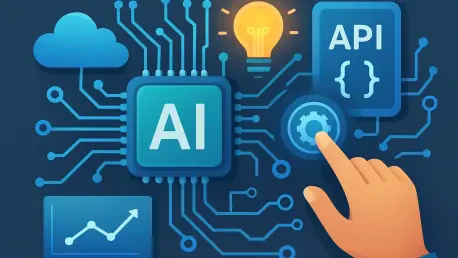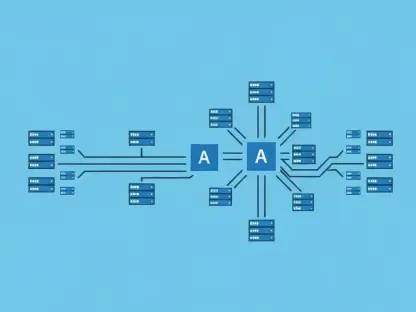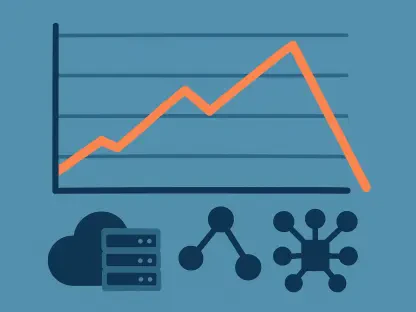In the fast-paced digital era of today, few technological pairings hold as much transformative potential as Artificial Intelligence (AI) and Application Programming Interfaces (APIs). Far from being mere tools in isolation, these two forces have forged a symbiotic relationship that amplifies their individual strengths, driving innovation across industries. Their interplay, recently highlighted at a prominent tech conference on September 4th, showcases how they are redefining the boundaries of what’s possible in software development and system integration. From simplifying the management of sprawling digital ecosystems to enabling intelligent systems to interact with the real world, this partnership is not just a trend but a cornerstone of modern advancement. As technology continues to evolve, understanding the depth of this collaboration becomes essential for grasping the future of digital solutions.
Understanding the Symbiotic Relationship
AI as a Catalyst for API Management
The complexity of managing vast API ecosystems poses a significant challenge for developers navigating thousands of endpoints in today’s digital landscape. APIs, as the critical connectors enabling data flow and functionality between platforms, often become unwieldy without proper oversight. AI emerges as a powerful ally in this context, introducing intelligent mechanisms to streamline processes that were once labor-intensive. By leveraging technologies like semantic search and vector embeddings, AI transforms API discovery into an intuitive task, allowing developers to locate the right tools swiftly based on intent rather than manual sifting. This shift not only saves time but also reduces frustration, paving the way for more efficient development cycles. The impact of such advancements is profound, as they enable a focus on creativity rather than logistical hurdles, fundamentally altering how digital services are built and maintained.
Beyond discovery, AI plays a pivotal role in refining the very structure of APIs through continuous updates and enhancements. Traditional API specifications often suffer from ambiguity or outdated information, creating barriers to effective usage. AI-driven agents address this by tirelessly reviewing and improving documentation for clarity and adherence to standards, often utilizing frameworks like the OpenAPI Overlay Specification. Additionally, integrated tools such as the DevNet Devvie VSCode Copilot Extension bring real-time support directly into development environments, offering instant access to updated resources and troubleshooting assistance. This acceleration of workflows ensures that developers can maintain momentum, tackling complex projects with greater ease. The result is a more robust and accessible API landscape, where the barriers to entry are lowered, and productivity is significantly boosted through intelligent automation.
APIs as Enablers of AI Functionality
APIs serve as the vital bridge that allows AI to move beyond theoretical models and into practical, real-world applications. Often metaphorically described as the “senses” and “hands” of AI, these interfaces enable systems to perceive environmental data through monitoring and state-fetching capabilities. Whether it’s gathering insights from IoT devices or pulling metrics from cloud platforms, APIs provide the raw input that fuels AI’s decision-making processes. This ability to “see” the world around it transforms AI into a responsive entity, capable of understanding context and reacting accordingly. Without such connectivity, the most advanced algorithms would remain isolated, unable to apply their intelligence to meaningful scenarios, underscoring the indispensable role of APIs in modern tech ecosystems.
Equally critical is the capacity of APIs to empower AI with the ability to act, turning insights into tangible outcomes. Through action-oriented endpoints, AI can execute commands like updating system configurations, provisioning user accounts, or automating routine tasks. This functionality positions AI as an autonomous agent, capable of not just analyzing data but also effecting change in physical and digital environments. For instance, an AI system might detect a server overload via monitoring APIs and then use action APIs to redistribute resources seamlessly. Such interactions highlight how APIs ground AI in practicality, ensuring that its potential is not confined to simulations but extends to impactful solutions. This dynamic completes the cycle of perception and response, cementing APIs as the backbone of AI’s real-world effectiveness.
Challenges in the AI-API Partnership
Scalability and the “Needle in a Haystack” Problem
One of the most daunting obstacles in the collaboration between AI and APIs is the issue of scalability, particularly when AI must navigate expansive API ecosystems. With thousands of potential endpoints to choose from, AI agents often face what is aptly termed a “needle in a haystack” dilemma, struggling to identify the most relevant tool or service for a given task. This overwhelming volume of options can lead to significant performance bottlenecks, as systems waste time evaluating irrelevant choices or fail to deliver optimal results. The challenge is not merely technical but also impacts the efficiency of broader development processes, as delays in decision-making ripple through project timelines. Addressing this barrier is crucial for ensuring that the partnership between these technologies remains productive and does not falter under the weight of its own complexity.
The implications of scalability issues extend beyond mere inconvenience, affecting the reliability and trust developers place in AI-driven systems. When an AI agent cannot swiftly pinpoint the correct API from a vast pool, it risks producing suboptimal outcomes or errors, undermining confidence in automated solutions. This problem is particularly acute in dynamic environments where real-time responses are critical, such as in financial trading platforms or emergency response systems. The sheer scale of modern API ecosystems, while a testament to their versatility, thus becomes a double-edged sword, amplifying the need for mechanisms that can intelligently filter and prioritize options. Without such interventions, the potential of AI to revolutionize API usage remains partially untapped, constrained by the very abundance that defines digital connectivity today.
Innovative Solutions to Overcome Barriers
To tackle the scalability challenges inherent in vast API ecosystems, forward-thinking solutions like the Relevance Funnel have emerged as game-changers. This approach employs a multi-stage filtering process to narrow down thousands of API options to a single, optimal choice. By integrating semantic search, contextual enrichment, and confidence-based reranking, the Relevance Funnel ensures that AI agents focus only on the most pertinent endpoints, drastically reducing decision-making time. This method not only enhances performance but also improves the accuracy of AI interactions with APIs, allowing for smoother integration into complex workflows. As a result, developers and systems can rely on AI to deliver precise outcomes, even in environments where choices are overwhelmingly abundant, marking a significant step forward in managing digital complexity.
Another promising innovation, known as the Arazzo Advantage, takes a structural approach to simplifying API interactions for AI systems. By bundling intricate, multi-step API workflows into single, high-level tools, this solution alleviates the cognitive load on AI agents, enabling them to execute complex tasks with greater precision. Instead of navigating a maze of individual endpoints, AI can interact with streamlined, purpose-built interfaces that encapsulate entire processes. This not only boosts efficiency but also minimizes the risk of errors that arise from misinterpreting or mismanaging API sequences. The Arazzo Advantage represents a proactive shift toward designing API ecosystems with AI usability in mind, ensuring that the scale of digital infrastructure becomes an asset rather than a hindrance. Together, these innovations lay a robust foundation for overcoming current barriers and fostering a more seamless collaboration.
Future Trends and Implications
A Fundamental Shift in Technology
The deepening integration of AI and APIs marks a pivotal shift in the technological landscape, one that promises to redefine how digital systems are designed and operated. No longer viewed as separate entities, these technologies are increasingly seen as interdependent forces, each enhancing the other’s capabilities in a continuous cycle of improvement. As API ecosystems grow ever more intricate with the proliferation of connected services, AI’s role in managing complexity through intelligent automation becomes not just beneficial but essential. This trend signals a move toward a future where the chaos of sprawling digital networks is tamed by smart systems, enabling developers to focus on innovation rather than logistics. The implications of this shift are vast, touching every corner of technology from enterprise solutions to consumer applications.
This evolving synergy also positions APIs as the critical foundation for grounding AI in practical, impactful scenarios over the coming years. As AI systems become more sophisticated, their reliance on APIs to interact with external environments will only intensify, driving demand for more robust and accessible interfaces. This mutual enhancement is poised to usher in a new wave of productivity, where streamlined processes benefit both human developers and automated systems. Looking ahead, the consensus among industry experts points to this partnership as a lasting driver of progress, with advancements in one domain directly fueling growth in the other. The trajectory suggests an era where technology operates with unprecedented efficiency, reshaping expectations for what digital tools can achieve in solving real-world problems.
Building on a Legacy of Collaboration
Reflecting on the journey so far, the collaboration between AI and APIs has already laid a remarkable foundation for innovation, overcoming early challenges with ingenuity and foresight. Solutions like the Relevance Funnel and Arazzo Advantage tackled scalability issues head-on, ensuring that AI could navigate vast digital ecosystems with precision and speed. Meanwhile, AI’s contributions to API management brought clarity to complex networks, empowering developers with tools that were once unimaginable. This reciprocal growth created a landscape where both technologies flourished, setting a precedent for how interconnected systems could drive progress. The strides made in refining workflows and enabling real-world applications stand as a testament to the power of symbiotic evolution in technology.
As attention turns to the road ahead, the focus should shift to building scalable frameworks that anticipate future complexities in API ecosystems and AI capabilities. Investing in adaptive solutions that evolve with technological advancements will be key to sustaining this momentum. Additionally, fostering collaboration between developers, AI researchers, and API architects can spark new ideas for integrating these tools in novel ways. Exploring open standards and interoperable systems could further enhance accessibility, ensuring that the benefits of this partnership reach diverse industries. By prioritizing these actionable steps, the tech community can continue to harness the transformative potential of AI and APIs, paving the way for a future where innovation knows no bounds.









